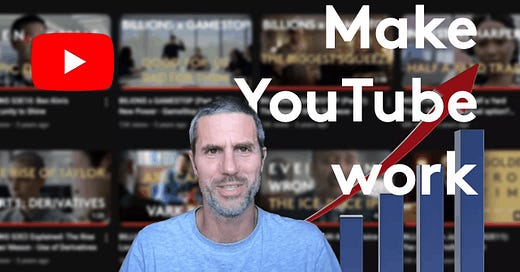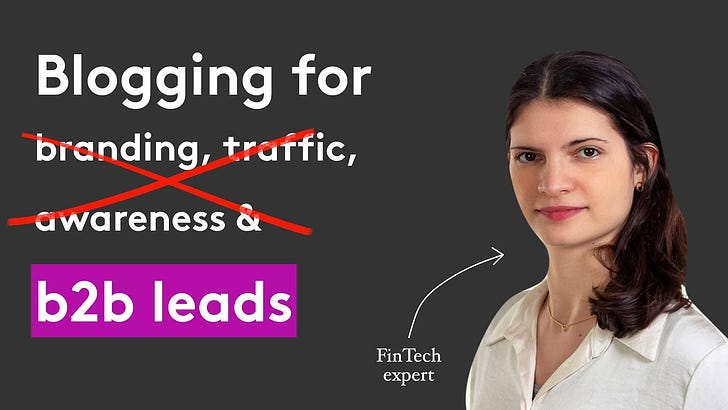Welcome to the new joiners. I’m George, from Orama a content studio that helps Β2Β brands grow with podcasts. The September sprint, a series of short solo episodes, continues.
When I posted earlier about YouTube, I was wondering: should B2B brands invest in YouTube? Here I share tips on how to make it work.
Listen to the podcast, read the edited transcript below, or watch the video for a visual bonus.
The InvestOrama channel is nearing the 20,000-follower milestone. We should reach it next month, and it happened with minimal recent effort, I only posted twice this year.
My podcast channel follows a similar organic growth path on YouTube - with the same level (or lack of) activity - a trend I don’t see on Apple Podcast and Spotify unfortunately. That inspired me to revisit my YouTube Journey and share some key learnings.
My YouTube Journey
My journey with YouTube began straight after I left finance. I started by offering YouTube channel management services and worked with channels across varied industries like food, jewellery, tech and sports. The brand channels I’ve worked with have accumulated around 100 million views. That number would be a total failure for any video of Mr Beast, but if you consider brand videos with a CTR of 0.5%, that’s potentially 500,000 new business opportunities.
YouTube users have changed. It used to be seen as a platform for independent creators. Soon media brands adopted it, then consumer brands, but 10 years ago very few brands could boast a million followers (Chanel was one of the first). Now, all prominent B2B tech brands such as AWS and Google Cloud heavily invest in YouTube and build significant audiences.
Whatever your technical topic, there’s an audience on YouTube for it. Creators who understood the platform's potential have long garnered millions of followers by sharing technical content, from math to coding.
Here are 20 essential tips from personal experience on YouTube (from my channels, or others):
👇🏼👇🏼👇🏼
If you want to fix your channel, but don’t want to spend time on it, I can help. There’s an offer at the bottom.20+ YouTube tips for brands
How to approach YouTube
1.You don't need to post all the time on YouTube or promote your content.
YouTube can do the work for you, like it did on my channels. The traffic comes from YouTube directly.
2.YouTube is reliable, unlike other social media platforms.
Do you remember Facebook’s pivot to video? (LinkedIn also had one, but it never took off).
3.The difference with other social networks is that it's based on content, not notoriety, not how popular you are already.
When Apple, or Nike (or the Pope) launched their Instagram account, they had millions of followers instantly. Just like BCG, Goldman, Amazon, did on LinkedIn. That’s not how it works on YouTube, where it’s about the content that you post.
4.It’s an opportunity for smaller brands to punch above their weight - that’s a consequence of the point above
5.It’s an opportunity for SEO
YouTube is the second largest search engine after its parent, Google. It is incredibly competitive if you look at the amount of videos posted.
But if you compare it to non-video content, it's a lot less competitive. If you have an SEO strategy, it's, it's not easy, but it's easier to compete on YouTube than just on the World Wide Web in general.
6.But it’s more than search.
But it's also a suggestion mechanism, and both combined means your content can live forever and be discovered by new people. That's unlike other social media where your posts have a lifespan of days or weeks max.
7.Analytics rule
YouTube provides a LOT of data, you can pinpoint your search terms and target them with free tools like vidIQ. And therefore it pays off to have a very analytical approach and that also means that brands that naturally have an analytical approach should have a competitive advantage by applying those skills.
8.The ROI is always high if the ‘I’ stays low
In terms of return on investment, well, it can be high because in my case, I haven't published much recently (the I - Investment is low) and it keeps growing and bringing in revenues directly (ads) and indirectly (sponsorships, courses).
But I did a lot of work upfront. Once you've built a proper show, a proper channel, once you find something that resonates, it has long-term benefits.
9-You should post regularly: it’s good advice, but it's not a golden rule.
This channel has just posted one video and has been growing ever since.
You can forget this preconception about having to post, weekly or even monthly, even if it's beneficial.
10-There are things that you can do to maintain the channel which are much less time-consuming than creating actual content.
Although I haven’t been posting, I regularly respond to comments. It just takes a few minutes and I enjoy it. I also tweak the titles and thumbnails based on the analytics that have been fed.
Optimization
11-Content and optimization are a product.
CONTENT X OPTIMIZATION = IMPACT
If you score 10 in content and 1 in optimization, it's going to be hard to break through. If you're very good at optimizing, but your content is not great, you won't have fantastic results.
But if you take care of both, then YouTube can really work for you, and optimizing is a lot less
12-There are 3 essential things that you need to think for optimization
Start with the title, thumbnail and description. Check your ‘Impressions click-through rate’. If it’s less than 1% you need to change something.
I've posted before about thumbnails and titles.
13-And then there are little things:
Think of playlists to organize your content. I don't think tags matter. But you have Cards and End Cards, which are powerful ways to link to other types of content. They can bring your CTR from 1 to 2 or 3 percent.
14-Analytics over Creative
Your optimization, includes copy and design, things that maybe B2B brands are not the most comfortable with, or are not part of their core skills. But, this is a simple fix, and with iteration and analytics, you can make it work.
15-Thumbnails and hooks are not clickbait
It’s something I've learned through YouTube that I'm not yet applying it to other content. Unfortunately, it's not enough to put valuable content in the hope that people will find you.
You really have to get them a strong incentive to click. And then to keep watching. I apply it fairly well on YouTube, but not on this blog, for example, and it’s something I want to improve.
About your videos
16-Resonance is key
When you find a point of resonance, just like in physics, when an item vibrates in response to oscillation, that matches its resonant frequency, it changes everything. So it's the same with your business. You need to find something in terms of style, content, and format that match your audience and things will start to click. The view count will start to rise. You'll have some feedback. All things will come together
17-There’s an audience for your niche, whatever it is.
That includes your B2B super specialized subsegment of FinTech or whatever. It's not boring. There are probably creators that are reaching millions of people, or just thousands of people on that topic. And I think the more niche you go, the better it is. But no, just publishing content is not enough.
18-Think of the format.
It’s the unique way you're going to present things. My channel didn’t work at first. I wanted to explain and clarify key technical aspects of finance. I used to post very “good” content with very good speakers. And it didn't really ‘work’ until I found the concept of linking it to series and financial scenes.
It’s pretty much the same content with the same people, but it’s reaching tens or sometimes a hundred thousand views per video.
A classic interview with an expert, Nicolas Rabener: 1,500 views
The same expert, but referring to a Billions episode: 55,000 views
19-Face the camera
For a long time, my channel was ‘faceless’. It's not very practical for me to film myself and also I don't like it. But I decided to embrace it, because you want to create this connection, especially if you're selling a service or something on top of your channel. At least people get a feeling of what it would be to talk to you, relate to you, and work with you. Don't shy away from that.
20-Apply your branding diligently, but it's about perfectible vs. perfect.
It will not be a 10 out of 10 for the first time, probably forever, but you can improve over time.
Keep the end goals in mind
21-Capture value outside YouTube
This is what creators do, and this is what brands should do as well. Try to capture emails straight away.
22-Selling is fine.
The content can be totally related to what you have to sell your product, your service. Explaining how your product and service can solve issues should probably be your strategy on YouTube. I use Ahrefs as a reference, they are doing it really well without being ‘pushy’. And they're cashing in significantly.
We're coming to the end of my “September sprints”. I hope you enjoyed them.
If you’re interested in making YouTube work for you, here’s an offer exclusive to clients and subscribers to this newsletter.
Free YouTube Audit
What is it?
We use various analytical tools to assess the completeness and performance of the channel. We will provide you with an assessment and some recommendations. (This is not an assessment of the quality of the content itself).
Why do I need that?
A YouTube audit would most likely precede a YouTube strategy. Once you know what works and what doesn’t, you can de-risk your content creation.
How does it work?
No login is required, we will scan your channel with various publicly available tools using YouTube APIs and that will be enough for a first report. If you want more details we can look at your analytics.
Get in touch here and provide your YouTube URL if you’re interested:















Share this post